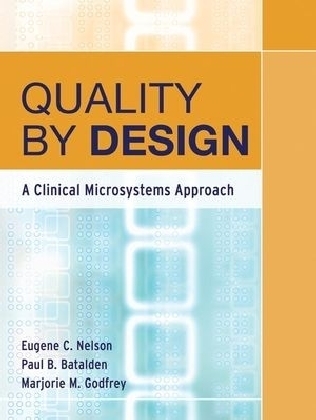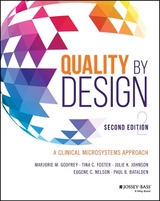
Quality By Design
Jossey-Bass Inc.,U.S. (Verlag)
978-0-7879-7898-3 (ISBN)
- Titel erscheint in neuer Auflage
- Artikel merken
Quality by Design reflects the research and applied training conducted at Dartmouth Medical School under the leadership of Gene Nelson, Paul Batalden, and Marjorie Godfrey. The book includes the research results of high-performing clinical microsystems, illustrative case studies that highlight individual clinical programs, guiding principles that are easily applied, and tools, techniques, and methods that can be adapted by clinical practices and interdisciplinary clinical teams. The authors
describe how to develop microsystems that can attain peak performance through active engagement of interdisciplinary teams in learning and applying improvement science and measurement;
explore the essence of leadership for clinical Microsystems;
show what mid-level leaders can do to enable peak performance at the front lines of care;
outline the design and redesign of services and planning care to match patient needs with services offered;
examine the issue of safety;
describe the vital role of data in creating a rich and useful information environment;
provide a core curriculum that can build microsystems’ capability, provide excellent care, promote a positive work environment, and contribute to the larger organization.
Ancillary materials for use in classroom teaching, training, or coaching are available at https://clinicalmicrosystem.org/
Eugene C. Nelson, D.Sc., M.P.H., is director of quality administration for the Dartmouth-Hitchcock Medical Center and professor of community and family medicine at Dartmouth Medical School. Paul B. Batalden, M.D. is the director of health care improvement leadership development, Center for the Evaluative Clinical Sciences, and professor of pediatrics and of community and family medicine at Dartmouth Medical School. Marjorie M. Godfrey, M.S., R.N., is instructor for community and family medicine at and director of the Clinical Microsystem Resource Group at Dartmouth Medical School .
Tables, Figures, and Exhibits xiii
Foreword xix
Donald M. Berwick
Preface xxiii
Acknowledgments xxvii
Introduction xxxi
The Editors xxxix
The Contributors xliii
Part One: Cases And Principles 1
1 Success Characteristics of High-Performing Microsystems: Learning from the Best 3
Eugene C. Nelson, Paul B. Batalden, Thomas P. Huber, Julie K. Johnson, Marjorie M. Godfrey, Linda A. Headrick, John H. Wasson
True Structure of the System, Embedded Systems, and Need to Transform Frontline Systems
The Bladyka Case
Research Design
Results
Practical Implications
Conclusion
2 Developing High-Performing Microsystems 34
Eugene C. Nelson, Paul B. Batalden, William H. Edwards, Marjorie M. Godfrey, Julie K. Johnson
Case Study: A Decade of Progress for an Intensive Care Nursery
A Model of Development and a Curriculum to Catalyze Microsystem Growth
Conclusion
3 Leading Microsystems 51
Paul B. Batalden, Eugene C. Nelson, Julie K. Johnson, Marjorie M. Godfrey, Thomas P. Huber, Linda Kosnik, Kerri Ashling
Leader, Leadership, Leading
Recap of Methods
Three Fundamental Processes of Leading: What Clinical Microsystem Team Members Observe and Report
Discussion
Conclusion
4 Leading Macrosystems and Mesosystems for Microsystem Peak Performance 69
Paul B. Batalden, Eugene C. Nelson, Paul B. Gardent, Marjorie M. Godfrey
Case Study: A True Story, with Names Changed to Protect the Innocent
Leadership Frameworks: Some of the Best Approaches
Leading Large Health Systems to Peak Performance Using Microsystem Thinking
Conclusion
5 Developing Professionals and Improving Worklife 106
Thomas P. Huber, Marjorie M. Godfrey, Eugene C. Nelson, Julie K. Johnson, Christine Campbell, Paul B. Batalden
Case Study: Staff Development at Massachusetts General Hospital Downtown Associates
Conclusion
6 Planning Patient-Centered Services 124
Marjorie M. Godfrey, Eugene C. Nelson, John H. Wasson, Julie K. Johnson, Paul B. Batalden
Planning Patient-Centered Services and the 5 P’s
Case Study: Planning Services for Subpopulations of Patients to Best Provide Care for Individual Patients
A Developmental Journey: Beginning to Assess, Understand, and Improve a Clinical Microsystem
Analysis and Improvement of Processes
A Huddle in Plastic Surgery
Conclusion
7 Planning Patient-Centered Care 148
John H. Wasson, Marjorie M. Godfrey, Eugene C. Nelson, Julie K. Johnson, Paul B. Batalden
Planning Care Well: Exemplary Clinical Microsystems
Planning Care in Any Microsystem
A Low-Tech Example for Ambulatory Services: CARE Vital Signs
Conclusion
8 Improving Patient Safety 165
Julie K. Johnson, Paul Barach, Joseph P. Cravero, George T. Blike, Marjorie M. Godfrey, Paul B. Batalden, Eugene C. Nelson
Microsystem Patient Safety Scenario
Case Study: Dartmouth-Hitchcock PainFree Program
Conclusion
9 Creating a Rich Information Environment 178
Eugene C. Nelson, Paul B. Batalden, Karen Homa, Marjorie M. Godfrey, Christine Campbell, Linda A. Headrick, Thomas P. Huber, Julie K. Johnson, John H. Wasson
Case Study 1: Specialty Care: Dartmouth-Hitchcock Spine Center
Case Study 2: Overlook Hospital Emergency Department
Case Study 3: Intermountain Health Care Shock Trauma Intensive Care Unit
Tips and Principles to Foster a Rich Information Environment
Discussion
Conclusion
Part Two: Activating the Organization And the Dartmouth Microsystem Improvement Curriculum 197
10 Overview of path forward And Introduction to part two 199
Recap of Part One and Overview of Part Two
Using Real Case Studies and Practical Applications of Microsystem Thinking, Methods, and Tools
Working at All Levels of a Health System
Focusing on the Microsystem Level
Review Questions
Prework
11 Introduction to Microsystem Thinking 230
What Is a System in Health Care?
How Did Clinical Microsystem Knowledge Evolve?
What Is a Clinical Microsystem?
Where Do Clinical Microsystems Fit in the Health Care Delivery System?
What Does a Clinical Microsystem Look Like?
Why Focus on the Clinical Microsystem?
How Do Clinical Microsystems Link to Crossing the Quality Chasm?
What Were the Findings of the Dartmouth Clinical Microsystem Research?
What Does a Microsystem’s Developmental Journey Look Like?
Conclusion
Case Studies
Review Questions
Between Sessions Work
12 Effective Meeting Skills I 243
What Is a Productive and Effective Meeting?
Why Use Meeting Skills and Roles?
What Are Effective Meeting Roles?
What Are the Phases of an Effective Meeting?
What Processes Are Evident in an Effective Meeting?
What Is the Seven-Step Meeting Process?
What Does a Meeting Agenda Template Look Like?
What Are the Ground Rules for Meetings?
What Are Some Tips for Getting Started with Productive Meetings?
How Do You Keep a Rhythm of Improvement?
Case Studies
Review Questions
Between Sessions Work
13 Assessing Your Microsystem with the 5 P’s 258
How Does an Interdisciplinary Lead Improvement Team Begin to Assess and Improve a Clinical Microsystem?
What Does the 5 P’s Framework Look Like?
What Resources Are Available to Guide the 5 P’s Assessment?
What Is a Helpful Way to Introduce Your Team to the Assessment Process?
What Are the 5 P’s?
What Should You Do with the Assessment Findings?
Case Studies
Review Questions
Between Sessions Work
14 The Model for Improvement: PDSA ↔ SDSA 271
What Is the Model for Improvement?
Why Use the Model for Improvement?
How Does the Model Fit into the Improvement Process?
What Is the PDSA Part of the Model?
What Are the Benefits of Using PDSA?
What Is Involved in Each of the Four Steps of Plan, Do, Study, and Act?
What Is the SDSA Cycle?
What Is Involved in Each of the Four Steps of Standardize, Do, Study, and Act?
What Tools Can Assist Your PDSA Cycle ↔ SDSA Implementation?
What Are Some Tips for Using the PDSA ↔ SDSA Method?
Case Studies
Review Questions
Between Sessions Work
15 Selecting Themes for Improvement 284
What Is a Theme for Improvement?
Why Use a Theme?
What Are the Theme Selection Considerations?
What Process Can You Use to Generate Theme Ideas and Select a First Theme?
What Are the Next Steps?
Case Studies
Review Questions
Between Sessions Work
16 Improvement Global Aim 291
What Is a Global Aim?
Why Use a Global Aim?
How Do You Write a Global Aim?
What Are the Next Steps?
Case Studies
Review Questions
Between Sessions Work
17 Process Mapping 296
What Is Process Mapping?
Why Use Process Mapping?
What Are the Commonly Used Flowchart Symbols?
What Does a High-Level Flowchart Look Like?
What Does a Detailed Flowchart Look Like?
What Are Some Tips for Creating a Flowchart?
What Does a Deployment Flowchart Look Like?
What Are Some Tips for Creating a Deployment Flowchart?
Case Studies
Review Questions
Between Sessions Work
18 Specific Aim 308
What Is a Specific Aim?
Why Use a Specific Aim?
Where Do Specific Aims Come From?
Where Does the Specific Aim Fit in the Overall Improvement Process?
How Do You Write a Specific Aim?
What Are the Next Steps?
Case Studies
Review Questions
Between Sessions Work
19 Cause and Effect Diagrams 313
What Is a Cause and Effect Diagram?
Why Use a Fishbone Diagram?
What Is the Structure of a Fishbone Diagram?
What Does a Completed Fishbone Look Like?
What Are Some Tips for Creating a Fishbone Diagram?
Case Studies
Review Questions
Between Sessions Work
20 Effective Meeting Skills II: Brainstorming and Multi-Voting 321
What Is Brainstorming?
What Are the Benefits of Brainstorming?
What Are Some Different Types of Brainstorming?
What Are Some Tips for Conducting Brainstorming?
What Is Multi-Voting?
Do Teams Always Multi-Vote After a Brainstorming Session?
How Do You Multi-Vote?
What Does a Brainstorming Session with a Multi-Voting Outcome Look Like?
Case Studies
Review Questions
Between Sessions Work
21 Change Concepts 331
What Is a Change Concept?
Why Use Change Concepts?
How Can You Use Change Concepts in a Process?
What Are the Next Steps?
Case Studies
Review Questions
Between Sessions Work
22 Measurement and Monitoring 339
What Are Measures, What Makes Measures Good, and How Do They Relate to Aims?
What Is a Run Chart?
What Are the Benefits of Using a Run Chart?
How Do Run Charts Fit in the Overall Improvement Process?
What Do Run Charts Tell You About Your Performance Level and Variation?
What Are Special Cause and Common Cause Variation?
How Do You Make a Run Chart?
How Do You Interpret Run Chart Results?
What Is a Control Chart?
What Is the Theory Behind Control Charts?
What Are the Benefits of Using a Control Chart Instead of a Run Chart?
What Are the Different Kinds of Control Charts?
What Is an XmR Control Chart?
How Do You Interpret Control Chart Results?
When Do You Recalculate Control Chart Values?
What Are Some Tips for Using Run Charts and Control Charts?
Case Studies
Review Questions
Between Sessions Work
23 Action Plans and Gantt Charts 362
What Is an Action Plan?
What Is a Gantt Chart?
Why Use Action Plans and Gantt Charts?
How Do You Write an Action Plan?
How Do You Create a Gantt Chart?
What Are the Next Steps?
Case Studies
Review Questions
Between Sessions Work
24 Follow Through on Improvement: Storyboards, Data Walls, and Playbooks 369
What Is the Importance of Follow Through?
What Can You Do to Follow Through?
What Are the Fundamentals of Improvement?
What Is a Data Wall?
What Is a Playbook?
How Is the Playbook Used?
How Do You Create a Playbook?
How Do You Maintain Your Playbook?
What Is a Storyboard?
How Do You Make a Storyboard?
Discussion
Case Studies
Review Questions
Between Sessions Work
25 Conclusion: Continuing on the Path to Excellence 380
Looking Back
Looking Forward and an Invitation: Make It Personal and Make It Happen
Appendix A: Primary Care Workbook 385
Name Index 433
Subject Index 437
| Erscheint lt. Verlag | 11.5.2007 |
|---|---|
| Verlagsort | New York |
| Sprache | englisch |
| Maße | 173 x 229 mm |
| Gewicht | 794 g |
| Einbandart | Paperback |
| Themenwelt | Medizin / Pharmazie ► Gesundheitswesen |
| ISBN-10 | 0-7879-7898-1 / 0787978981 |
| ISBN-13 | 978-0-7879-7898-3 / 9780787978983 |
| Zustand | Neuware |
| Informationen gemäß Produktsicherheitsverordnung (GPSR) | |
| Haben Sie eine Frage zum Produkt? |
aus dem Bereich



